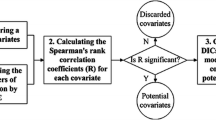Abstract
Flood frequency analysis is usually based on the fitting of an extreme value distribution to the local streamflow series. However, when the local data series is short, frequency analysis results become unreliable. Regional frequency analysis is a convenient way to reduce the estimation uncertainty. In this work, we propose a regional Bayesian model for short record length sites. This model is less restrictive than the index flood model while preserving the formalism of “homogeneous regions”. The performance of the proposed model is assessed on a set of gauging stations in France. The accuracy of quantile estimates as a function of the degree of homogeneity of the pooling group is also analysed. The results indicate that the regional Bayesian model outperforms the index flood model and local estimators. Furthermore, it seems that working with relatively large and homogeneous regions may lead to more accurate results than working with smaller and highly homogeneous regions.









Similar content being viewed by others
References
Acreman M, Wiltshire S (1989) The regions are dead: long live the regions. In: FRIENDS, vol 187. International association of hydrological sciences, Washington, pp 175–188
Balkema A, de Haan L (1974) Residual life time at great age. Ann Probab 2:792–804
Burn DH (1990) Evaluation of regional flood frequency analysis with a region of influence approach. Water Resources Res 26(10):2257–2265
Coles S (2001) An introduction to statistical modelling of extreme values. Springer Series in Statistics. Springer, London
Coles S, Pericchi L (2003) Anticipating catastrophes through extreme value modelling. J R Stat Soc C 52(4):405–416
Coles S, Tawn J (1996) A bayesian analysis of extreme rainfall data. J R Stat Soc Ser C Appl Stat 45(4):463–478
Crowder M (1992) Bayesian priors based on a parameter transformation using the distribution function. Ann Inst Stat Math 44(3):405–416
Dalrymple T (1960) Flood frequency analysis. US Geol Surv Water Supply 1543A
Development Core Team R (2005) A language and environment for statistical computing. R Foundation for Statistical Computing, Vienna, Austria. http://www.R-project.org. ISBN 3-900051-07-0
Embrechts P, Klüppelberg C, Mikosch T (1997) Modelling extremal events for insurance and finance. Springer, Berlin Heidelberg New York
Fill HD, Stedinger JR (1998) Using regional regression within index flood procedures and an empirical bayesian estimator. J Hydrol 210(1–4):128–145
Fisher RA, Tippett LH (1928) Limiting forms of the frequency distribution of the largest or smallest member of a sample. Proc Cam Phil Soc 24:180–190
Gabriele S, Arnell N (1991) A hierarchical approach to regional flood frequency analysis. Water Resources Res 27(6):1281–1289
GREHYS (1996) Inter-comparison of regional flood frequency procedures for Canadian rivers. J Hydrol 186(1–4):85–103
Gupta VK, Mesa OJ, Dawdy DR (1994) Multiscaling theory of flood peaks: Regional quantile analysis. Water Resources Res 30(12):3405–3421
Hall MJ, Minns AW, Ashrafuzzaman AKM (2002) The application of data mining techniques for the regionalisation of hydrological variables. Hydrol Earth Syst Sci 6(4):685–694
Hosking JRM, Wallis JR (1993) Some statistics useful in regional frequency analysis. Water Resources Res 29(2):271–281
Hosking JRM, Wallis JR (1997) Regional frequency analysis. Cambridge University Press, Cambridge
Katz RW, Parlange MB, Naveau P (2002) Statistics of extremes in hydrology. Adv Water Resources 25(8–12):1287–1304
Lang M, Ouarda TBMJ, B.Bobée B (1999) Towards operational guidelines for over-threshold modeling. J Hydrol 225(3–4):103–117
Madsen H, Rosbjerg D (1997) Generalized least squares and empirical bayes estimation in regional partial duration series index-flood modeling. Water Resources Res 33(4):771–781
Northrop PJ (2004) Likelihood-based approaches to flood frequency estimation. J Hydrol 292(1–4):96–113
Parent E, Bernier J (2003) Encoding prior experts judgments to improve risk analysis of extreme hydrological events via pot modeling. J Hydrol 283(1–4):1–18
Pickands J III (1975) Statistical inference using extreme order statistics. Ann Statist 3:119–131
Robinson JS, Sivapalan M (1997) An investigation into the physical causes of scaling and heterogeneity of regional flood frequency. Water Resources Res 33(5):1045–1059
Robson AJ, Reed DW (1999) Flood estimation handbook, vol 3. Institute of Hydrology, Wallingford
Shu C, Burn DH (2004) Artificial neural network ensembles and their application in pooled flood frequency analysis. Water Resources Res 40(9):W09301
Wasson JG, Chandesris A, Pella H, Blanc L (2004) Hydro-ecoregions: a functional approach of river typology for the European water framework directive. Ingénieries EAT in French 40:3–10
Acknowledgements
The authors wish to thank the DIREN Rhône-Alpes for providing data. The authors are also very grateful to the two referees for their constructive remarks which improved the document.
Author information
Authors and Affiliations
Corresponding author
Appendix: Properties of the index flood on GP parameters
Appendix: Properties of the index flood on GP parameters
We provide in this appendix the proof for the following theorem:
Theorem 1Let X be a random variable GP distributed. So X has the cumulative distribution function defined by:
LetY = CXwhere\(C \in \mathbb{R}_{*}^{+}.\)Then, Y is also GP distributed with parameters (μ C,σ C,ξ).
Proof Let X be a r.v. GP distributed with parameters (μ, σ, ξ) and Y = CX where \(C \in \mathbb{R}_{*}^{+}.\) Then:
So, Y is also GP distributed with parameters (μ C,σ C,ξ). The proof for the GEV case can be established in the same way.
Rights and permissions
About this article
Cite this article
Ribatet, M., Sauquet, E., Grésillon, JM. et al. A regional Bayesian POT model for flood frequency analysis. Stoch Environ Res Risk Assess 21, 327–339 (2007). https://doi.org/10.1007/s00477-006-0068-z
Published:
Issue Date:
DOI: https://doi.org/10.1007/s00477-006-0068-z




